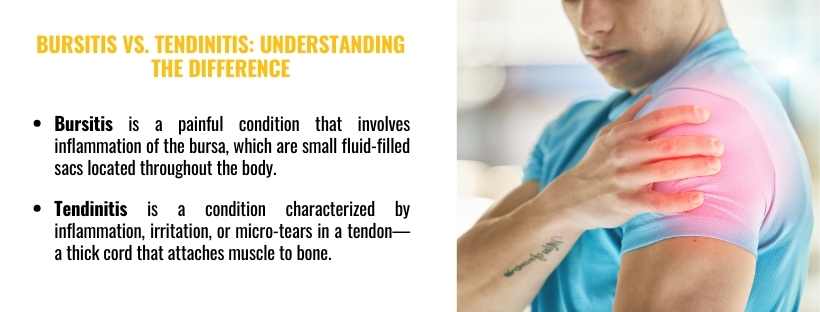Shoulder pain can be debilitating, affecting daily activities and overall quality of life. Among the myriad of shoulder conditions, bursitis and tendinitis stand out as two common culprits.
These conditions involve inflammation of different structures within the shoulder joint, leading to discomfort and restricted mobility.

While they share similarities, they also exhibit distinct characteristics that require careful differentiation for proper management.
What Is Bursitis And Tendinitis?
-
Bursitis
Bursitis is a painful condition that involves inflammation of the bursa, which are small fluid-filled sacs located throughout the body, including around joints in the:
- Shoulders (subacromial bursitis)
- Elbows (olecranon bursitis)
- Hips (trochanteric bursitis)
- Knees (prepatellar bursitis)
These bursae act as cushions between bones, tendons, muscles, and skin, reducing friction and allowing smooth movement of the joints.
When the bursae become irritated or inflamed, bursitis can develop. The inflammation causes the affected bursa to swell and become tender, resulting in pain, stiffness, and limited range of motion in the affected joint.
-
Tendinitis
Tendinitis, or tendonitis, is a condition characterized by inflammation, irritation, or micro-tears in a tendon—a thick cord that attaches muscle to bone.
Tendons play a crucial role in facilitating movement and transmitting the force generated by muscles to the bones, allowing for joint motion and stability.
Common sites for tendinitis include the shoulders (rotator cuff tendinitis), elbows (tennis elbow or golfer’s elbow), wrists (de Quervain’s tenosynovitis), knees (patellar tendinitis), and heels (Achilles tendinitis).
What Causes Bursitis And Tendinitis?
Bursitis typically results from repetitive movements, overuse, poor posture, or trauma to the shoulder joint. It may also be the result of an underlying medical condition, such as arthritis, gout, or infection.
On the other hand, tendinitis often develops due to repetitive motions, aging, or sudden injury. Certain medical conditions, such as diabetes, thyroid disorders, or autoimmune diseases, can impair tendon health and increase the risk of tendinitis.
Symptoms: How Do They Differ?
Both bursitis and tendinitis manifest with similar symptoms, such as pain, swelling, and limited range of motion in the shoulder. However, certain nuances distinguish between the two conditions.
- In bursitis, the pain tends to localize over the affected bursa, commonly at the top of the shoulder or the outer side.
- Tendinitis pain typically occurs along the tendon’s path, which may radiate down the arm or worsen with specific movements. Additionally, In some cases, there may be a palpable lump or crepitus (crackling sensation) when moving the tendon.
Diagnosis: How Are They Identified?
Accurate diagnosis of bursitis and tendinitis relies on a thorough medical history, physical examination, and diagnostic tests.
During the examination, the physician may assess the range of motion, perform provocative maneuvers, and palpate the affected area to elicit pain or tenderness.
While bursitis and tendinitis share similar symptoms and diagnostic approaches, certain features can help differentiate between the two conditions:
Location of pain
Bursitis typically presents with localized pain and tenderness over the affected bursa, which is often located near a joint.
In contrast, tendinitis pain tends to follow the path of the affected tendon, which may be palpable and tender along its course.
Aggravating factors
The pain associated with bursitis may worsen with movement or pressure over the affected bursa, such as during overhead activities or when lying on the affected side.
Tendinitis pain, on the other hand, may be exacerbated by specific movements or actions that engage the affected tendon, such as gripping, lifting, or reaching.

Imaging findings
Imaging studies such as ultrasound or MRI may reveal specific changes indicative of bursitis or tendinitis, such as fluid accumulation within the bursa or thickening of the affected tendon. However, these findings may overlap, and clinical correlation is essential for accurate diagnosis.
What Are The Treatment Options For These Two Conditions?
The treatment options for bursitis and tendinitis aim to alleviate pain, reduce inflammation, and promote the healing of the affected tissues. Some examples of treatment approaches include:
Rest
Limiting activities that exacerbate symptoms and avoiding repetitive movements can help reduce irritation and allow the inflamed bursa and affected tendon to heal.
Ice therapy
Applying ice packs to the affected area for 15-20 minutes several times a day can help reduce inflammation and alleviate pain. Be sure to wrap the ice pack in a cloth to prevent skin irritation.
Nonsteroidal anti-inflammatory drugs (NSAIDs)
Over-the-counter NSAIDs such as ibuprofen (Advil, Motrin) or naproxen (Aleve) can help relieve pain and reduce inflammation. However, long-term use should be monitored due to potential side effects.
Physical therapy
A physical therapist can design a customized exercise program to improve strength, flexibility, and range of motion in the affected joint.
Corticosteroid injections
Injections of corticosteroids directly into the inflamed bursa or tendon can provide rapid and targeted relief of pain and inflammation.
Surgical intervention
In severe cases where conditions do not respond to conservative treatments, surgical repair of the damaged tendon or surgical removal of the inflamed bursa (bursectomy) tissue may be necessary.
However, surgery is often a last resort option and reserved for cases with significant functional impairment.
Where can I find the best shoulder specialist?
Searching for top-notch shoulder care in the Miami area? Your quest ends here! South Florida International Orthopaedics stands as the premier provider of orthopedic services in the South Florida region. We are renowned for our commitment to excellence, compassionate care, and cutting-edge treatments.

South Florida Orthopedics is at the forefront of orthopedic innovation, offering the latest advancements in shoulder care. We provide comprehensive orthopedic services, such as arthroscopic surgery and Kendall sports medicine, to address various shoulder conditions, such as:
- Rotator cuff tears
- Shoulder labrum tear
- Dislocated shoulder
- Shoulder impingement
- Frozen shoulder
- Shoulder arthritis
- And more!
Rediscover mobility, comfort, and confidence in your shoulder health. Contact us today to get in touch with the best doctor of orthopedic in Kendall.
The material contained on this site is for informational purposes only and DOES NOT CONSTITUTE THE PROVIDING OF MEDICAL ADVICE, and is not intended to be a substitute for independent professional medical judgment, advice, diagnosis, or treatment. Always seek the advice of your physician or other qualified healthcare providers with any questions or concerns you may have regarding your health.
